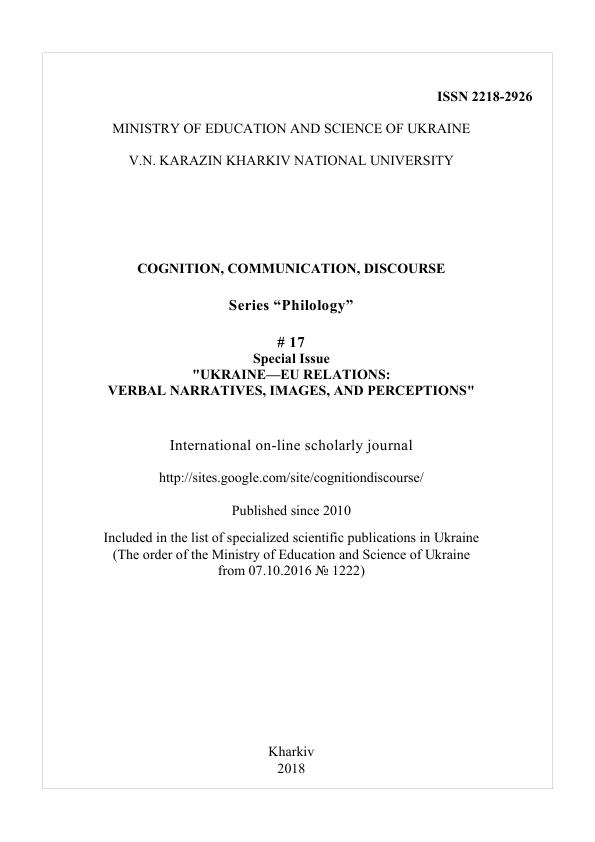Constructing bridges and fostering growth: Interdisciplinary insights into European Union conceptions and perceptions
Abstract
This article studies the EU’s role conceptions and projections towards its Eastern Neighbourhood, and Ukraine specifically. Informed by the novel focus on narratives and emotions in International Relations (IR) theory and in EU foreign policy studies, we propose an innovative interdisciplinary synergy between IR’s role theory [Harnisch et al. 2011; Holsti, 1970] and cognitive linguistics’ conceptual metaphor theory [Lakoff and Johnson 1980]. Using the tool of conceptual metaphor, we systemically explore the EU’s role conception (self-image) as well as its perception and expectations of the Eastern partners (role prescriptions). In doing so, we put forward a new method to systemically analyse cognitive and emotive elements in the EU’s foreign policy roles based on the notion that conceptual metaphors reveal fundamental cognitive and emotional traits central to the roles actors play. Empirically, we analyse the EU Global Strategy (June 2016) and the EU Eastern Partnership (EaP) Summit’s Official Memorandum (November 2017), as well as 12 interviews with EU practitioners dealing with Ukraine (conducted in 2017).
Downloads
References
Aggestam, L. (2006). Role Theory and European Foreign Policy: A Framework for Analysis. In Elgström, O. and Smith, M. (eds) The European Union’s Roles in International Politics. Concepts and Analysis. London and New York: Routledge.
Bengtsson, R., & Elgström, O. (2012). Conflicting Role Conceptions? The European Union in Global Politics’. Foreign Policy Analysis, 8 (1), 93-108.
Chaban, N., Kelly, S. (2017). Tracing the evolution of EU images using a case-study of Australia and New Zealand. Journal of Common Market Studies, 55 (4), 691–708.
Council of the European Union (2017). Joint Declaration of the Eastern Partnership Summit (Brussels, 24 November). Available from http://www.consilium.europa.eu/media/31758/final-statement-st14821en17.pdf
Chilton, P. A. (1996). Security metaphors. Cold War discourse from containment to common house. New York: Peter Lang.
Davis Cross, M., & Karolewski, I. (2017). What Type of Power has the EU Exercised in the Ukraine–Russia Crisis? A Framework of Analysis. Journal of Common Market Studies, 55 (1), 3–19.
Drulák, P. (2004). Metaphors Europe lives by: language and institutional change of the European Union, EUI Working Paper SPS 2004/15, Florence: European University Institute. Available from http://hdl.handle.net/1814/2632.
Elgström, O., & Smith, M. (eds) (2006). The European Union’s roles in international politics. London: Routledge.
EU Global Strategy (EUGS) (2016). Available from http://europa.eu/globalstrategy/en/global-strategy-foreign-and-security-policy-european-union
Flanik, W. (2011). “Bringing FPA back home”: cognition, constructivism, and conceptual metaphor. Foreign Policy Analysis, 7 (4), 423-446.
Harnisch, S. (2011). Role Theory: Operationalization of Key Concepts. In Harnisch, S. Frank, C. and Maull, H.W. (eds.). Role Theory in International Relations. London and New York: Routledge, 7-15.
Harnisch, S., Frank, C., & Maull, H.W. (eds) (2011). Role Theory in International Relations. London and New York: Routledge.
Holland, M., & Chaban, N. (2011). The EU as an agent for democracy: images of the EU in the Pacific media “mirror”. Journal of European Integration, 33 (3), 285-330.
Holsti, K. (1970). National role conceptions in the study of foreign policy. International Studies Quarterly, 14 (3), 233-309.
Howorth, J. (2017). Stability on the Borders: The Ukraine Crisis and the EU’s Constrained Policy towards the Eastern Neighbourhood. Journal of Common Market Studies, 55 (1), 121–136.
Jansen, S. C., & Sabo, D. (1994). The sport-war metaphor: hegemonic masculinity, the Persian-Gulf war, and the new world order’ Sociology of Sport Journal, 11 (1), 1-17.
Klose, S. (2018). Theorizing the EU's Actorness: Towards an Interactionist Role Theory Framework. Journal of Common Market Studies, First published: 30 March 2018, DOI: 10.1111/jcms.12725.
Lakoff, G., & Johnson, M. (1980). Metaphors we live by. Chicago: University of Chicago Press.
Marks, M. P. (2011). Metaphors in International Relations Theory. New York: Palgrave Macmillan.
Musolff, A. (2010). Political Imagery of Europe: a house without exit doors?’. Journal of Multilingual and Multicultural Development, 21 (3), 216-229.
Opperman, K., & Spencer, A. (2013). Thinking alike? Salience and metaphor analysis as cognitive approaches to foreign policy analysis. Foreign Policy Analysis, 9 (1), 39-56.
Orenstein, M., & Keleman, R.D. (2017). Trojan Horses in EU Foreign Policy. Journal of Common Market Studies, 55 (1), 87–102.
Rohrer, T. (1995). The metaphorical logic of (political) rape: George Bush and the new world order. Metaphor & Symbolic Activity, 10 (2), 113-131.
Thies, C., & Breuning, M. (2012), Integrating Foreign Policy Analysis and International Relations Theory through Role Theory. Foreign Policy Analysis, 8 (1), 1-4.
Authors, who publish with this journal, accept the following conditions:
The authors reserve the copyright of their work and transfer to the journal the right of the first publication of this work under the terms of the Creative Commons Attribution License (CC BY), which allows other persons to freely distribute a published work with mandatory reference to the authors of the original work and the first publication of the work in this journal.
Authors have the right to enter into separate additional agreements for the non-exclusive dissemination of the work in the form in which it was published by this journal (for example, to post the work in the electronic institutions' repository or to publish as part of a monograph), provided that the link to the first publication of the work in this journal is given.
The journal policy allows and encourages the authors to place the manuscripts on the Internet (for example, in the institutions' repositories or on personal websites), both before the presentation of this manuscript to the editorial board and during review procedure, as it contributes to the creation of productive scientific discussion and positively affects the efficiency and dynamics of citing the published work (see The Effect of Open Access).




